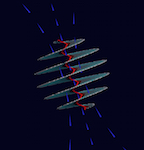Editor’s note: Links to images for download appear at the end of this release.
David Ruth
713-348-6327
david@rice.edu
Mike Williams
713-348-6728
mikewilliams@rice.edu
Graphene nano-coils are natural electromagnets
Rice University researchers discover graphene spirals could challenge macro solenoids
HOUSTON – (Oct. 16, 2015) – In the drive to miniaturize electronics, solenoids have become way too big, say Rice University scientists who discovered the essential component can be scaled down to nano-size with macro-scale performance.
The secret is in a spiral form of atom-thin graphene that, remarkably, can be found in nature, according to Rice theoretical physicist Boris Yakobson and his colleagues.
“Usually, we determine the characteristics for materials we think might be possible to make, but this time we’re looking at a configuration that already exists,” Yakobson said. “These spirals, or screw dislocations, form naturally in graphite during its growth, even in common coal.”
The researchers determined that when a voltage is applied, current will flow around the helical path and produce a magnetic field, as it does in macro inductor-solenoids. The discovery is detailed in a new paper in the American Chemical Society journal Nano Letters.
“One can compare the structure to a high-rise parking lot for electrons — but without parking spaces, so the electrons just drive through,” Yakobson said. “Or you can say it resembles Archimedes’ screw — which rotates in order to pump water uphill — but filled with electricity instead.
“Perhaps this might work in reverse here: An electron current, pumped through by the applied voltage, at certain conditions may just cause the graphene spiral to spin, like a fast little electro-turbine,” he said.
Solenoids are wires coiled around a metallic core. They produce a magnetic field when carrying current, turning them into electromagnets. These are widespread in electronic and mechanical devices, from circuit boards to transformers to cars. They also serve as inductors, primary components in electric circuits that regulate current, and in their smallest form are part of integrated circuits. (The lump in power cables that feed electronic devices contains inductors.)
While transistors get steadily smaller, basic inductors in electronics have become relatively bulky, said Fangbo Xu, a Rice alumnus and lead author of the paper. “It’s the same inside the circuits,” he said. “Commercial spiral inductors on silicon occupy excessive area. If realized, graphene nano-solenoids could change that.”
The nano-solenoids analyzed through computer models at Rice should be capable of producing powerful magnetic fields of about 1 tesla, about the same as the coils found in typical loudspeakers, according to Yakobson and his team. They found the magnetic field would be strongest in the hollow, nanometer-wide cavity at the spiral’s center.
The spiral form is attributable to a simple topological trick, he said. Graphene is made of hexagonal arrays of carbon atoms. Malformed hexagons known as dislocations along one edge force the graphene to twist around itself, akin to a continuous nanoribbon that mimics a mathematical construct known as a Riemann surface.
The researchers demonstrated theoretically how energy would flow through the hexagons in nano-solenoids with edges in either armchair or zigzag formations. In one case, they determined the performance of a conventional spiral inductor of 205 microns in diameter could be matched by a nano-solenoid 70 nanometers wide – nearly 10,000,000 times smaller.
Because graphene has no energy band gap (which gives a material semiconducting properties), electricity should move through without any barriers. But in fact, the width of the spiral and the configuration of the edges – either armchair or zigzag – influences how the current is distributed, and thus its inductive properties.
The researchers suggested it should be possible to isolate graphene screw dislocations from crystals of graphitic carbon (graphene in bulk form), but enticing graphene sheets to grow in a spiral would allow for better control of its properties, Yakobson said.
Xu suggested nano-solenoids may also be useful as molecular relays or switchable traps for magnetic molecules or radicals in chemical probes.
Co-authors are Rice graduate student Henry Yu and alumnus Arta Sadrzadeh. Yakobson is the Karl F. Hasselmann Professor of Materials Science and NanoEngineering and a professor of chemistry.
The research was supported by the Office of Naval Research’s Multidisciplinary University Research Initiative (MURI), the National Science Foundation and the Air Force Office of Scientific Research MURI.
-30-
Read the abstract at http://pubs.acs.org/doi/abs/10.1021/acs.nanolett.5b02430
Follow Rice News and Media Relations via Twitter @RiceUNews
Related Materials:
Yakobson Research Group: http://biygroup.blogs.rice.edu
Rice Department of Materials Science and NanoEngineering: https://msne.rice.edu
George R. Brown School of Engineering: http://engr.rice.edu
Images for download:
https://news2.rice.edu/files/2015/10/1019_SOLENOID-1-WEB.jpg
A nano-coil made of graphene could be an effective solenoid inductor for electronic applications, according to researchers at Rice University. (Credit: Yakobson Research Group/Rice University)
https://news2.rice.edu/files/2015/10/1019_SOLENOID-2-WEB.jpg
A nano-coil made of graphene could be an effective solenoid inductor for electronic applications, according to researchers at Rice University. (Credit: Yakobson Research Group/Rice University)
Located on a 300-acre forested campus in Houston, Rice University is consistently ranked among the nation’s top 20 universities by U.S. News & World Report. Rice has highly respected schools of Architecture, Business, Continuing Studies, Engineering, Humanities, Music, Natural Sciences and Social Sciences and is home to the Baker Institute for Public Policy. With 3,888 undergraduates and 2,610 graduate students, Rice’s undergraduate student-to-faculty ratio is 6-to-1. Its residential college system builds close-knit communities and lifelong friendships, just one reason why Rice is ranked No. 1 for best quality of life and for lots of race/class interaction by the Princeton Review. Rice is also rated as a best value among private universities by Kiplinger’s Personal Finance. To read “What they’re saying about Rice,” go here.



